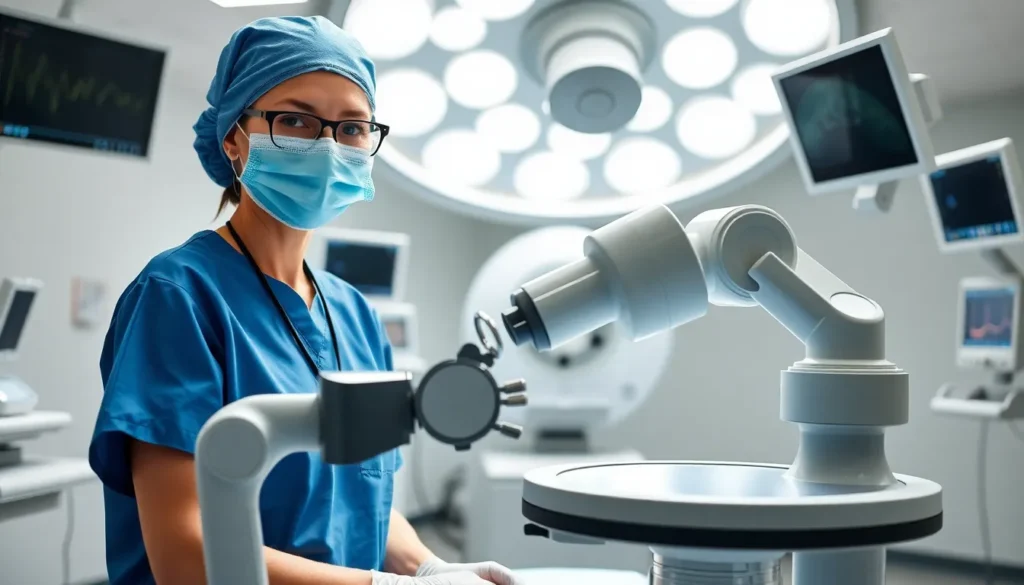Table of Contents
ToggleImagine a world where surgery doesn’t mean long scars and weeks of recovery. Enter minimally invasive surgery, the superhero of the surgical realm. With tiny incisions and advanced techniques, it’s like trading in a bulldozer for a precision drone. Patients can get back to their lives faster, and who doesn’t want that?
Overview of Minimally Invasive Surgery
Minimally invasive surgery (MIS) significantly reduces recovery time compared to traditional methods. Surgeons use tiny incisions, often smaller than one inch, which minimizes tissue damage. This technique utilizes advanced imaging and instrumentation, allowing for precise operations within the body. Patients benefit from shorter hospital stays and experience less postoperative pain.
Common procedures using MIS include laparoscopic cholecystectomy and arthroscopy. These procedures not only result in smaller scars but also decrease the risk of infection. Minimal blood loss occurs during these surgeries, contributing to quicker recoveries. It takes patients less time to return to daily activities when opting for MIS.
In 2020, nearly 50% of all surgical procedures in the United States adopted minimally invasive techniques. Surgeons trained in these methods achieve outcomes similar to or better than those of traditional surgery. The continuous development of surgical technology drives the advancement of MIS. Innovations like robotic-assisted surgery enhance precision and control during procedures.
Educating patients about the benefits of minimally invasive surgery is essential. They often express preferences for quicker recovery and reduced pain. Surgeons engage in discussions about the suitability of MIS for their specific conditions. Overall, this approach aligns with the evolving landscape of modern medicine, emphasizing patient-centered care and improved surgical outcomes.
Benefits of Minimally Invasive Surgery

Minimally invasive surgery (MIS) offers numerous advantages that enhance patient experiences and outcomes.
Reduced Recovery Time
Patients experience significantly shorter recovery periods through MIS. Tiny incisions lead to less tissue trauma, resulting in faster healing. For instance, studies show that patients may return to normal activities in just days compared to weeks required after traditional surgery. In 2020, surgical data indicated that nearly 50% of surgical procedures integrated minimally invasive techniques, further proving its adoption in medical practices. As a result, hospitals often see enhanced patient turnover and increased efficiency.
Decreased Pain and Scarring
Pain levels typically decrease with minimally invasive procedures. Smaller incisions contribute to less nerve and tissue damage, moderating discomfort after surgery. Furthermore, patients appreciate the reduced visibility of scars, as smaller incisions minimize scarring compared to traditional methods. Many patients report satisfaction with their cosmetic outcomes, feeling more confident post-operation. The focus on aesthetic results enhances the overall appeal of MIS, making it a popular choice among surgical options.
Common Types of Minimally Invasive Surgery
Minimally invasive surgery includes various techniques, each offering unique advantages. These methods enhance patient recovery and satisfaction.
Laparoscopic Surgery
Laparoscopic surgery employs small incisions, often around one centimeter, allowing surgeons to insert a camera and specialized instruments. This technique minimizes trauma to surrounding tissues, leading to reduced recovery times. Many patients experience less post-operative pain, enabling them to return to normal activities within days. Procedures such as laparoscopic cholecystectomy, used to remove the gallbladder, exemplify this efficiency. With this method, hospital stays are typically shorter, with many patients discharged within 24 hours.
Robotic-Assisted Surgery
Robotic-assisted surgery enhances precision through advanced robotic systems that allow surgeons to perform intricate procedures with greater control. Surgeons manipulate the robotic arms while sitting at a console, providing a three-dimensional view of the surgical field. This method proves beneficial for complex operations, such as prostatectomies and hysterectomies. Commonly, it results in less blood loss and minimizes scarring, contributing to faster recoveries. In 2020, over 10% of all minimally invasive surgeries in the U.S. utilized robotic assistance, highlighting its growing adoption across surgical specialties.
Patient Considerations
Minimally invasive surgery (MIS) presents various patient considerations crucial for informed decision-making. Understanding eligibility criteria and potential risks allows for better outcomes.
Eligibility for Minimally Invasive Procedures
Not every patient qualifies for minimally invasive procedures, though many do. Certain factors influence eligibility, including the patient’s overall health and the specific condition being treated. Factors such as age, pre-existing medical conditions, and previous surgeries can impact the decision. Surgeons evaluate these elements comprehensively before recommending MIS. Candidates often experience conditions like gallbladder disease or joint injuries, since these ailments benefit significantly from MIS techniques. Communicating openly during consultations helps identify suitable candidates for these advanced procedures.
Risks and Complications
While minimally invasive surgeries generally come with lower risks, complications can still occur. Common issues include infection, bleeding, and adverse reactions to anesthesia. Surgeons inform patients about these potential risks to ensure they make well-informed choices. Patients especially need to understand that individual risk factors vary, making thorough pre-operative assessments vital. Further, recovery phases present challenges, like discomfort or delayed healing. Patients must follow post-operative instructions closely to minimize these risks and promote a smoother recovery. Data shows that with proper screening and experienced surgical teams, the rates of complications decrease significantly, reinforcing the value of careful planning.
Future of Minimally Invasive Surgery
Minimally invasive surgery (MIS) continues to evolve, promising even greater advancements in patient care. Emerging technologies, like augmented reality and artificial intelligence, enhance surgical precision and planning. Surgeons anticipate integrating these tools, enabling more personalized surgical approaches and improved outcomes.
Additionally, the potential expansion into various medical fields, including cardiovascular and orthopedic surgeries, signals a broadening adoption of MIS techniques. In 2020, over 50% of surgical procedures in the U.S. incorporated minimally invasive methods, emphasizing their increasing acceptance. As surgical teams achieve successful outcomes, interest in MIS is likely to rise further.
Robotic-assisted surgery stands at the forefront of these innovations. Current data shows that over 10% of minimally invasive surgeries utilized robotic assistance in 2020. Surgeons credit robotic systems with offering enhanced dexterity and visualization, resulting in fewer complications and improved recovery experiences.
Furthermore, collaboration among healthcare professionals fosters ongoing research and development in MIS. Compilation of data from various studies helps identify best practices and guide new procedures. Expectation surrounds ongoing education for surgical teams to master the latest technologies, enhancing their capabilities.
Patient perspectives will influence the future of MIS as well. Educating individuals about their options encourages informed decisions regarding surgical approaches. Patients increasingly prioritize shorter recovery times and minimal pain, making MIS an appealing choice moving forward.
Finally, continuous exploration of new techniques and tools aims to reduce risks associated with surgery. Emphasis on rigorous screening processes ensures that patients receive optimal care tailored to their needs. As the field evolves, minimally invasive surgery is set to revolutionize surgical practices, enhancing both patient experience and clinical outcomes.
Minimally invasive surgery is transforming the landscape of surgical care. With its focus on reduced recovery times and improved patient outcomes, it’s becoming the preferred choice for many procedures. As technology continues to advance, the integration of robotic assistance and innovative tools promises even greater precision and safety.
Patients are increasingly aware of the benefits associated with MIS, leading to a growing demand for these techniques. By prioritizing patient-centered care and ongoing research, the future of surgery looks promising. Embracing these advancements not only enhances surgical practices but also significantly improves the overall patient experience.







